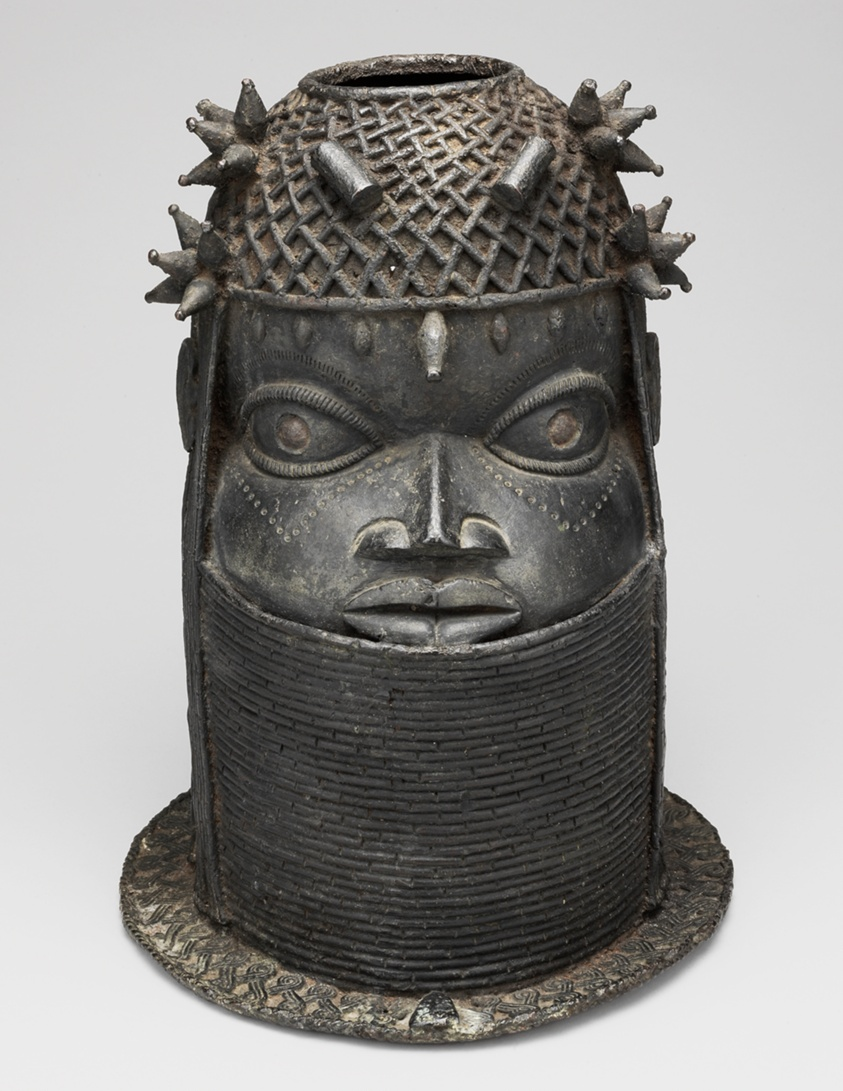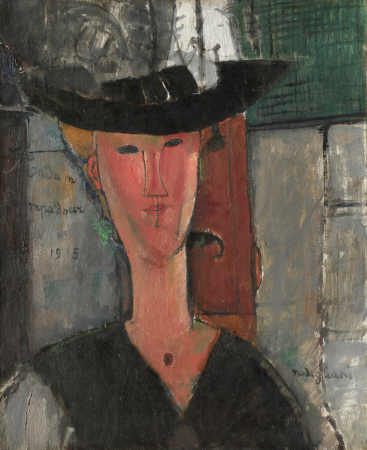15 Why Do People Take What Doesn’t Belong to Them?
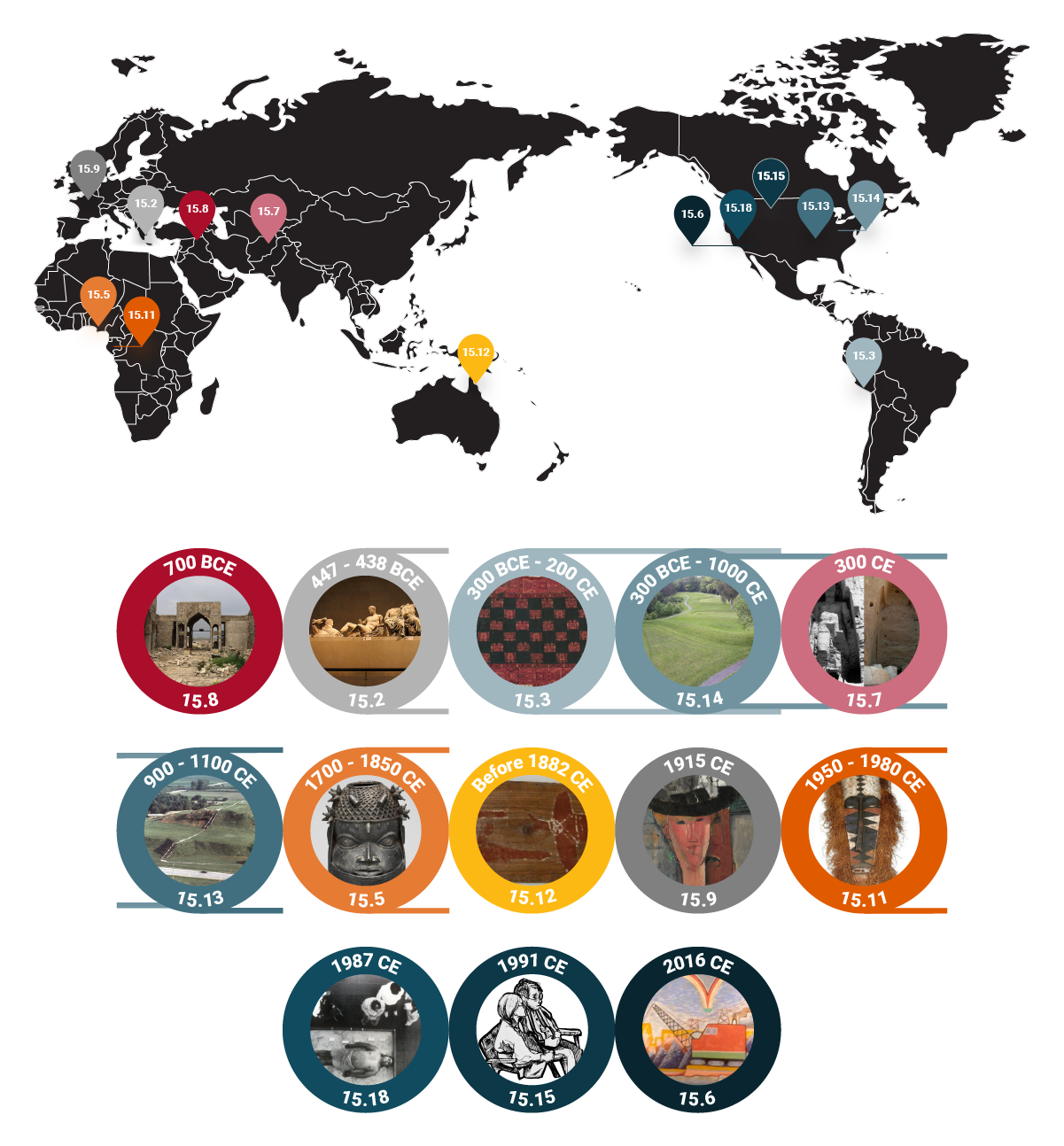
Why do people take what doesn’t belong to them?
When it comes to theft and art, you may think of thrilling heists like in the movies “Ocean’s Eight” (2018) or “The Thomas Crown Affair” (1999 or 1968). Or you may have watched the recent documentary “This is a Robbery: The World’s Biggest Art Heist” (2021) about the Isabella Stewart Gardner Museum heist in 1990. These are the highly publicized or imagined losses that the public connects to the art world. But there are many less visible types of loss and theft that don’t get talked about as much. In this chapter, we’ll talk about colonial theft and related museum acquisition, repatriation/restitution debates (regarding return of the objects to the country or owner of origin), looting (illegal removal of cultural objects from their place of origin), ideologically-motivated destruction, intellectual theft, and the impacts of these losses. The title of this chapter implies a notion of ownership over ancient and historic arts. But it is important to fundamentally consider the question of ownership. Does anyone actually own the past and objects or monuments that represent that past?
These topics aren’t fun like heist movies but some examples are quite famous, like the removal of marble sculptures from the Acropolis in Athens, Greece, between 1801-1812 CE. The so-called ‘Elgin Marbles’ (Fig. 15.2) were taken by the British Lord Elgin as his personal property, claiming he had permission from the Ottoman government that ruled Greece at the time. Outcries of looting and vandalism from the British public compelled him to not keep them. But he didn’t return them to Greece. He sold them to the British government. Eventually, the marbles went into the British Museum collection, where they remain today.
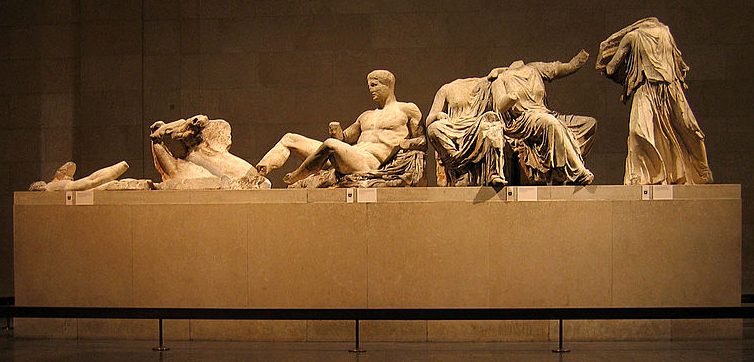
After Greece gained independence, they wanted the Acropolis sculptures back, calling for repatriation. The British Museum continually denies repatriation requests by the Greek government and international bodies like UNESCO. The Greek government and many citizens feel the loss of these art objects are a loss of their heritage and the practical potentials that heritage offers local communities (like economic benefits from tourism). Threats like looting and other forms of cultural destruction are long-established and continuing (sometimes growing), impacting the identities, heritage, and perspectives of cultures that have been poorly treated, underrepresented, and ignored.
How did this stuff get here? Why is it here?
Most museum-goers don’t ask these questions as they view objects, but we will. Remember Ana De Orbegoso’s Neo-Huaco #3 (Fig. 8.15) from “Who Came Before Us?” Andrew Hamiliton (2020, para. 7), curator at the Art Institute of Chicago (AIC) that owns De Orbegoso’s artwork and the Portrait Vessel of a Ruler (Fig. 8.14), states that Neo-Huaco #3 “emphasizes the commodification of Andean antiquities and the contemporary art market….” Why would De Orbegoso focus on that topic? Check out the AIC catalog page for Portrait Vessel of a Ruler, and open the Provenance section near the bottom. Provenance refers to the record of ownership of an object. The AIC offers this information:
Eduard Gaffron (1861–1931), Lima, Peru, from 1892 to 1912, then Berlin; [then] by descent to his children Mercedes Gaffron [in] Berlin then [in] Durham [South Carolina] and Hans Gaffron (1902–1979) [in] Berlin, then Chicago; sold to the Art Institute, 1955.
Gaffron was a German ophthalmologist who lived in Peru for 20 years, during which time he collected over 11,000 antiquities. Gaffron sold many objects to other collectors outside Peru and retained many that eventually were inherited by his children (Mercedes and Hans), who sold Portrait Vessel of a Ruler (along with many other objects) to AIC in 1955. This provenance starts with Eduard Gaffron in Peru. But De Orbegoso likely also wants us to ask: how did Gaffron get an object like the portrait vessel in the first place?
Hamilton (2020, Fig. 7) includes a historic photograph in his essay of another German researcher who participated in the extraction of ancient Peruvian objects and seven people noted as “unidentified huaqueros” in the caption. The term huaquero is an amalgamation of an indigenous word, huaca (waqa), from the native Quechua language of the Andes and the Spanish suffix –ero, used to describe specific activities/roles related to objects (i.e. vaquero [deriving from vaca (cow)] equates to herdsman or ‘cowboy’ in English). Within indigenous communities today, huaca/o (gendered via the grammatical requirements of Spanish) retains its original meaning: an object or thing that is sacred. All ancient objects and buildings are paid reverence by being called huacas/huacos. Thus, Portrait Vessel of a Ruler is a huaca. De Orbegoso creates her own term, Neo-Huaco, by playing on this ancient term. So, huaqueros and huaqueras were people within Spanish-controlled Peru with specific roles related to huacas.
What were these roles? You guessed it… they were hired by foreigners, like Gaffron, to dig up ancient sites in the Peruvian desert, collect huacas of all kinds, and help the foreigners transport the huacas back to cities like Lima. Then, the huacas were eventually exported to Europe, the US, and elsewhere. How did all of this start, you ask? You guessed it, again… Spanish colonization. As discussed in “What is Divine?”, Spanish conquistadores and colonial leaders had a lust for gold that led them to dig up graves and temples across Peru. They employed or enslaved local people to help them do that. The huaquero role was born.
With Neo-Huaca #3, De Orbegoso may be reflecting upon this history of foreigner-led extraction of ancient remains with the help of local people, the very people who consider such objects sacred. We can ask how force, economic need, loss of cultural knowledge, and other factors influenced these activities. Locals also led independent looting activities, usually selling objects to foreigners to make a profit. Such local looting continues to occur today all over the world, where people in need see an opportunity to profit from the value placed on ancient objects by the art market.
De Orbegoso’s work relates to another set of objects, the so-called ‘Shroud of Gothenburg’ and 88 other Paracas textiles, similar to Woven and Embroidered Mantle (Fig. 15.3), from Peru (Fig. 15.1). How did they get to Gothenburg, Sweden, you ask? In 1929 CE, Peru established legislation to protect its antiquities (after folks like Gaffron had removed so many things in previous eras). Political changes just a few years later meant that leaders protecting huacas were ousted from their jobs and archaeological sites were unprotected. Looting activity skyrocketed between 1931 and 1932 CE, even as reports were made to the authorities. While we do not know exactly who the looters were, we know that 89 Paracas textiles were removed from the mummies they originally encased. In fact, these looters carelessly tossed the mummified remains onto the ground and left them exposed. This indicates that the looters were not indigenous people, most of whom held strong feelings of ancestry and reverence for the Paracas culture.
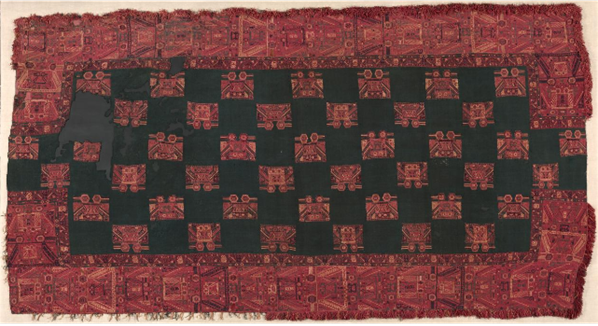
The 1929 antiquities law was set up to combat looting and exportation of such huacas from Peru. It wasn’t enforced due to the political turmoil. Because of this, a Swedish diplomat named Sven Karell was able to illegally export the Paracas textiles to Sweden, eventually forming part of the collection of the National Museums of World Culture in Gothenburg. Peru began requests for repatriation in 2009 CE, after the Gothenburg museums did an exhibition exposing the illegal circumstances of the objects. The process was long, with the museum citing the fragile condition of the textiles, but in June 2014 CE, Gothenburg began a long-term repatriation effort to the Museo Nacional de Arqueología (MUNA), starting with 4 textiles. The entire collection was to be repatriated by 2021 CE, though the coronavirus pandemic probably affected these plans. No matter when the entire collection is back in Peru, it needs extensive conservation, since ancient textiles are extremely fragile. Check out “Analysis of Paracas fibre material from the Gothenburg Collection” (Javer 2017) for analysis of the first 4 textiles already returned to Peru. MUNA will incur high costs for treatment and storage, hopefully to be recouped by increased tourism to the museum.
The Gothenburg example is one of the success stories that are increasing in recent years. These include cases where ownership is totally transferred or where other agreements are put in place. For example, while the British Museum denies Greek claims for repatriation of the Parthenon marbles, they did accept an agreement with the Kwakwaka’wakw First Nation. Remember the Transformation Mask (Fig. 6.4) from “What is Important to Us?” Another Kwakwaka’wakw transformation mask was the subject of repatriation claims focused on recovering objects obtained in bad faith and sold by the Canadian government.
In 1876 CE, the Canadian government passed the ‘Indian Act,’ which banned all indigenous peoples from practicing potlatching (as described in “What is Important to Us?”). In 1921 CE, Kwakwaka’wakw Chief Cranmer defied the law and Canadian authorities raided Chief Cranmer’s potlatch and arrested the participants. Some were imprisoned and some were released after they agreed to surrender approximately 750 cultural objects to the officials that conducted the raid. Most of these objects were handed to the Canadian government and eventually displayed in the Canadian Museum of Civilization (CMC) while some were sold to the Smithsonian National Museum of the American Indian (NMAI) and smaller museums like the Cranmore Ethnographical Museum in Kent, England. The masks sold to Cranmore were eventually transferred to the British Museum. The Kwakwaka’wakw U’mista Cultural Centre requested the return of these objects, eventually receiving repatriated objects from CMC and NMAI. But their dealings with the British Museum were different. They negotiated a “long-term loan” of this mask in 2005 CE. This means that the British Museum still owns the object (and display it in exhibitions when it wishes, such as the 2017 “Where the Thunderbird Lives” show in London) but allows the U’mista Cultural Centre to display it in their own space most of the time.
There’s another ongoing repatriation debate that involves the British Museum that you may have heard of, or learned about based on some recent popular media. Are you a fan of “Black Panther” (2018)? That film features a scene where the character Killmonger visits the West African gallery of a museum (marked as the “Museum of Great Britain” on a building sign) displaying (fictional) Wakandan objects (Fig. 15.4 – CONTENT WARNING: This video depicts physical violence). A verbal confrontation between Killmonger and a museum curator violently culminates in the death of the curator and other museum workers. Killmonger and his accomplices take several Wakandan objects, seeking Vibranium as a valuable resource. He also describes the loss of cultural heritage and the thefts of the colonial era that resulted in African objects being exported to European and US museums.
CONTENT WARNING: This video depicts physical violence.
In fact, Killmonger asks the curator about several objects on display. The curator says that the second object is from “the Edo people of Benin, 16th century” (Fig. 15.4). Firstly, the filmmakers should have edited the dialogue for historical accuracy because it sounds like the curator is saying that the Edo people lived in the present-day country of Benin. They didn’t. They lived in the present-day country of Nigeria. The Edo established one of the most powerful pre-colonial states of Africa, known as the Kingdom of Benin, centered at Benin City in present-day Nigeria (Fig. 15.1). That name was not attributed to the present boundaries of Benin (the country) until 1975 CE when it replaced the name Dahomey, as the French colony of Dahomey dissolved.
Getting back to that second object Killmonger asks about… check it out at minute 0:40 in Figure 15.4. This isn’t a real object (and Vibranium isn’t real, btw). The filmmakers created an object that strongly resembles a carved ivory object representing Queen Iyoba from the Kingdom of Benin but changed its appearance to look like Benin brass sculptures, such as Uhunmwun Elao (Fig. 15.5). Thus, the object in the film is an amalgamation and inaccurate but serves to represent the important tension between the descendants of the Kingdom of Benin in Nigeria today and the British Museum (not so subtly alluded to by the sign “Museum of Great Britain”).
Uhunmwun Elao was cast by expert brass smiths within the palace guild to honor a recently deceased Oba (king). The head is a portrait of the Oba, identified by the sumptuous adornments of coral beads and the scarification marks beneath the eyes and on the forehead, illustrating the great prestige and experience of this leader. Though distinct, this portrait recalls the Portrait of an Ife King with crown (Fig. 13.5) with a strong focus on naturalism and stately presence. Uhunmwun Elao was a prominent feature on an altar dedicated to the deceased Oba’s memory, created and maintained by his successor. An intricately carved elephant tusk would be inserted in the hole in the top of the portrait. The tusk carving would offer information about the oba’s reign and his prowess.
The AIC currently owns/holds Uhunmwun Elao. So, you asking yourself how this portrait of a dead Benin king ended up there, right? Let’s check out the Provenance section on the AIC website again:
Oba Ovonrramwen, (r. 1888-97, died 1914), Benin City, Kingdom of Benin, before 1897; possibly taken during the British military raid. [To] Dr. Hans Meyer (died 1929), Leipzig, Germany, from 1900 [Receipt from Jacques Seligmann and Company in curatorial file]; by descent to Mrs. Hans Meyer, 1929; sold to Jacques Seligmann and Company, New York, N.Y., 1933; sold to Mrs. George W. Crawford (née Annie Laurie; married Russell B. Aitken, 1957; died 1984), 1940; by descent to Russell B. Aitkens, 1984; sold, Christie’s, New York, April 3, 2003, sale 1278 (The Russell B. Aitken Collection of African, American Indian, and Oceanic Art), lot 62, to the Art Institute.
Before a German, an American, another American, a third American, and then an American art institution owned this object, it was the property of an Oba of Benin. Then, the AIC notes it was “possibly taken during the British military raid.” What raid, you ask…
By the 1890s CE, the Kingdom of Benin was in control of their territory, unlike many other African kingdoms under colonial rule at that time. The Benin Obas were successful in trade and in protecting their territory through Portuguese, Dutch, and British contact, eventually monopolizing regional trade of palm oil, rubber, and ivory. The British leaders of the Niger Coast Protectorate (a British colony in present-day southeastern Nigeria) sought ways to break the Benin Kingdom’s economic hold, including making it a British colony (thereby profiting from their economic success). In 1892 CE, a British official visited the Oba with a proposal to annex the kingdom and offer security as a British protectorate. The Oba originally considered this a friendly trade agreement but soon realized it was a deception targeting colonization. In response, the Oba prohibited British occupation and trade in Benin lands.
The British did not take kindly to being barred from going where they wanted. Several British attempts to enforce colonization failed but led to additional measures by the Oba, such as embargoing palm oil trade. This hit the British in their pocketbooks, inspiring disdain for the Benin Kingdom (which was already quite high due to British views of how Benin slaves were treated as well as human sacrifice practices). A rogue British military official, James Robert Phillips (without approvals from his commanding officers), sent a message to the Oba indicating that he was coming for peace talks. Instead, he invaded across the Benin Kingdom border with 250 African soldiers (recruited into the British colonial army) disguised as porters and musicians. Benin leaders feared a surprise invasion on Benin City and encouraged the Oba to attack them first. The Oba did not want to go on the offensive but several chiefs did. They attacked the disguised British forces in January 1897 CE, killing 8 combatants and injuring around 40.
As a response to this attack, the British military mounted the so-called ‘Benin Punitive Expedition’ in February 1897 CE. Punitive refers to punishment; the British set out to punish the Benin leaders. Thousands of British soldiers invaded Benin City and surrounding villages While sacking and burning, British forces killed tens of thousands of people, as estimated by Dan Hicks (2021) in The Brutish Museums: The Benin Bronzes, Cultural Violence and Cultural Restitution. The Oba was captured and exiled. As part of this violent action, British officials looted Benin palaces and shrines amassing over 2500 objects, very likely including Uhunmwun Elao and objects directly reflecting the heritage of Benin leaders. Photographs from this period of looting, such as this one and this one, document the destruction and collection of war booty, including cans of palm oil at the feet of the soldiers.
Any guesses where those 2500 Benin objects went? Some went into private collections of those who participated in the raid, and before the end of 1897 CE, many were auctioned off to German museums and private collectors, other European museums, including the British Museum, and institutions in the US. Who got the profits from those sales, you ask? The British military did. This was Phillips’ original motive, which becomes clear when you read his letter seeking permission to invade: “…I have reason to hope that sufficient ivory would be found in the King’s house to pay the expenses [of the invasion].” He didn’t expect all the cast brass artworks, stores of palm oil, and other goods in addition to the ivory looted from Benin City.
Currently, the British Museum holds around 900 objects looted during the ‘Benin Punitive Expedition.’ The Ethnologisches Museum Berlin-Dahlem holds approximately 530 objects and 1,130 objects are retained within Germany overall. Many other looted objects are held in French and US institutions. In 2000 CE, Oba Ovonrramwen’s descendants issued a repatriation claim to the British Parliament (which you can read here), focused on this request:
“All the cultural property belonging to the Oba of Benin illegally taken away by the British in 1897, should be returned or [the British should pay monetary compensation, based on the current market value] to the rightful owner, the Oba of Benin.”
The British Museum has refused to fulfill this request, stating that they purchased the objects legally and did not participate in the looting. The British Museum also consistently says that the Oba of Benin, and/or Nigeria, cannot care for the objects as state-of-the-art museums in Europe can. Recently, the British Museum has discussed creating long-term loan agreements, like with the U’mista Cultural Centre, to allow Nigerian institutions to display objects permanently.
Despite not actually participating in the looting, France agreed to return Benin objects in 2018 CE (though they have yet to actually return anything as of 2022). In addition, Germany acknowledges that the plundering of the Benin Kingdom was an act of war and that retaining objects obtained as booty and sold for military profit is not right. In July 2022, Germany signed an agreement to return over 1000 Benin objects (This Day 2022). The physical return should coincide with the completion of a new museum in Benin City, called the Edo Museum of West African Art. This museum project has come about through the Benin Dialogue Group. This would be one of the institutions in Nigeria to take on long-term loans from the British Museum if that proposal moves forward.
More destruction
These cases of looting are just a few of the many circumstances that have led to objects being illegally and/or unethically removed from their place of origin. Looting is one form of destruction that reduces and/or destroys cultural heritage and the information that we can learn from it. For example, Wallis Budge, a curator of Egyptology at the British Museum, illegally removed the Papyrus of Ani (Fig. 10.3) from Egypt in 1888 CE by CUTTING THE SCROLL INTO 37 PIECES! This allowed him to box the flat sheets up and travel with it easily. That’s why the papyrus is shown in ‘frames’ in “What Happens When We Die?”. They are segments cut by Budge so he could steal it from Egypt. Do you think it stops there? No. Budge was paid 150 pounds by the British government as a “gratuity.” He got a tip for stealing the Papyrus of Ani!
Other forms of destruction are much bigger in scale, such as the bulldozing of ancient sites. Hopi artists Michael Kabotie and Delbridge Honanie illustrated just that in their large mural painting Hopi Visions (Fig. 15.6). The entire composition visualized the Hopi past, present, and a hopeful future. The past section, seen on the first/leftmost panel, includes a kiva, an illustration of the creation story emergence, and an image of Pueblo Bonito discussed in “Will You Tell a Story?”. Then, the imagery shifts to the Spanish colonial period, Catholic missionizing, and the Pueblo Revolt of 1680. The middle panel represents the flourishing of Hopi culture through agriculture, social life, and the Kachina traditions (discussed in “Who Came Before Us?”). The third panel takes a turn to the modern period, beginning with a bulldozer removing an ancient Hopi site to build a highway. The land is scarred and history is removed with the swipe of a machine. The mural continues by visualizing some of the current issues Hopi people face, including alcoholism, drugs, and obesity. Despite these challenges, the mural ends with a picture of interconnectedness, intercultural conversation, and hope. Kabotie and Delbridge incorporated the image of the bulldozer to literally visualize destruction, loss, and what happens as cultural heritage takes a back seat to ‘progress,’
Can you think of another example of destructive acts that result in cultural heritage loss? You may be aware of the ideologically-motivated destruction of the Bamiyan Buddhas (Fig. 15.7 left) of present-day Afghanistan (Fig. 15.1). These were two monumental sculptures, one of Shakyamuni Buddha and one of Vairocana (Celestial) Buddha (the form he assumed after nirvana), carved into niches on the side of a large cliff in the Bamiyan Valley. Looking at the site today, you won’t see anything other than two empty niches that once held the monumental sculptures (Fig. 15.7 right). The Bamiyan Buddhas were explosively demolished in 2001 by the Taliban.

Before we talk about their destruction and the reasons behind it, let’s dive into the history and significance of the Bamiyan Buddhas. They were carved between 550-650 CE in the Gandharan style, that syncretic mix of Ancient Greek and Buddhist artistic traditions that developed as a result of the invasion of Alexander the Great and subsequent Greek settlement in Bactria, as discussed in “Will You Tell a Story?”.
Both Bamiyan Buddhas were carved in high relief into niches in the cliffside. High relief means that the form of the sculpture projects far enough outward to be mostly independent from the background, but is not completely free from the rock face behind. The heads of the Bamiyan Buddhas were carved ‘in the round,’ meaning fully independent of the cliffside like a freestanding statue. The high relief at the base is important because it allowed worshippers to circumambulate the Buddhas, like at the Mahastupa (“Why Does Size Matter?”), inside the niches. In addition, the Buddhas were once brightly painted (like ancient Greek sculptures), and historical records by Chinese monk Xuanzang reference their glowing copper faces, hands, and adornment with precious gems. Just imagine how impressive they would have looked in their prime!
Bamiyan was a center of Buddhist activity even before the construction of the two Buddhas, and there already existed (and still exist today) hundreds of Buddhist caves carved into the cliffs. In addition, Bamiyan was located at a key position on the Silk Roads, with caravans frequently passing through the valley. For many of these caravans, Bamiyan was either their last stop before (if traveling east), or their first stop after (if traveling west) crossing a dangerous stretch of the Silk Road. As you can imagine, crossing vast stretches of empty, unpopulated areas across the Hindu Kush mountains and Taklimakan Desert while carrying lots of valuable goods was extremely risky due to factors such as armed bandits and robbers, intense heat and cold, sandstorms, and poisonous snakes. As such, the giant Buddhas served to provide either an opportunity to pray and make offerings for a safe journey ahead, or a comforting and relieving presence for someone thankful to have made it through that section of the Silk Road unharmed.
After towering over the Bamiyan Valley for almost 1400 years, the Buddhas were systematically destroyed by the Taliban in 2001 CE. Taliban leader Mullah Omar ordered the destruction of all non-Islamic monuments and figures throughout Afghanistan in February of that year. Despite international pleas, the Buddhas were brought down in March over the course of several weeks by Taliban forces through a combination of anti-aircraft artillery, mines, rockets, and dynamite (which goes to show how strong these Buddhas physically were!). The Taliban recruited local people to place explosives, including Sayid Mirza Hussain (Behzad and Qarizadah 2015).
So, we’ve got to ask: why did the Taliban want to destroy non-Islamic imagery? Multiple reasons come into play. Buddhism had long since faded as the predominant religion in Afghanistan following Muslim conquests, and Afghanistan was almost fully Islamic by 1000 CE. In the 1990s, the Taliban seized control of Afghanistan from the former Soviet-backed Afghan government following a long civil war after the collapse of the USSR. As an Islamist movement, the Taliban adhered very strongly to literalist principles of Islam and harshly enforced Islamic Sharia law, a law code based on the words of the Qur’an, the Hadith, and consensus developed over time. As we discussed in “What is Divine?”, the Qur’an restricts the imitation of Allah’s creations and influences interpretations about figural imagery within many Muslim communities. Some fundamentalist or literalist interpretations see all anthropomorphic representation of a spiritual nature as heretical. The Taliban and previous Islamic governments/empires of Afghanistan throughout history had often dealt with this by destroying the faces of religious figures, a practice called iconoclasm. In fact, the Bamiyan Buddhas had had their faces forcibly removed at some point (see Fig. 15.7 right), actions which many experts attribute to previous acts of iconoclasm.
So why did the Taliban shift from their previous policies regarding icons to destroying the Bamiyan Buddhas completely? Evidence points toward a Taliban reaction against the international community. In fact, the Taliban had previously sworn not to destroy, but even to protect and conserve, the Bamiyan Buddhas and other Afghan pre-Islamic artifacts. However, in 2001, international sanctions had recently been imposed on the Taliban government over its reluctance to extradite terrorist Osama bin Laden. Furthermore, the Taliban had been intensely frustrated by offerings of foreign aid not to its citizens suffering from hunger and drought, but solely for the restorations of the Bamiyan Buddhas. Deeming this a double standard, the Taliban destroyed the statues to send a message of strength, indignance, and unwillingness to bow down to the demands of foreigners. Following the destruction, the Taliban even flew in journalists to visit the area where the Buddhas once stood to report their destruction to the wider international community.
The Taliban’s actions remain controversial, especially given the recent 2021 withdrawal of US forces, swift Taliban take-over, and establishment of a new Taliban-based government in Afghanistan. It is up to you to learn more and consider your opinion on the matter. There is no doubt that there was a great loss at Bamiyan and it affects the cultural heritage of millions of people. “Between Cult and Culture: Bamiyan, Islamic Iconoclasm, and the Museum” (Flood 2002) offers additional information but, as always, shouldn’t be the only source of your investigation to learn more.
If you hadn’t heard of the Bamiyan Buddhas, chances are that you’ve heard of more recent ideologically-motivated destruction of cultural heritage, by ISIS/ISIL in Syria and northern Iraq. Like the Taliban, ISIS/ISIL was motivated to remove non-Islamic imagery from the regions of their control. Using public media forums, they published videos of destruction of artworks at museums with sledgehammers and bulldozing entire archaeological sites, including a long-lived Christian monastery, Dair Mar Elia, in present-day Mosul, Iraq. Figure 15.8 records the destruction at Nineveh, Iraq, taken by UNESCO officials. Nineveh was one of the capitals of the Assyrian Empire (Fig. 15.1) The Southwest Palace of Nineveh was built in the 700s CE and was devastated by bulldozing and explosives in 2017. These examples demonstrate that destruction of ancient heritage is not just a thing of the past, with bad characters like Wallis Budge. It continues and takes many forms today.
Appropriation and its impacts
Looting and destruction are extremely devastating, not only as physical loss but as cultural loss. There are other losses that do not necessarily remove objects from their place of origin but factor into the loss of cultural heritage and/or acknowledgement. This sort of loss can occur through appropriation (using pre-existing imagery for your own purposes, sometimes without permission or credit given to the original artist).
We’ve already mentioned appropriation in art by Hank Willis Thomas and the Guerrilla Girls in “Why Do I Have To Do What You Say?” You may have heard of Appropriation Art (with capital ‘A’s) that developed in the 1960s CE. It focused on intentional and subversive appropriative acts. Just think of Andy Warhol’s Campbell’s Soup Cans. Before that art movement, a more tacit form of appropriation was common practice, especially among young artists who learned skills by copying the masters relevant to their region. This was how all the revered artists of the Renaissance, for example, developed their skills and built their own styles. As discussed in “Where Does Art Come From? An Introduction,” in the 1800s CE, European artists started being influenced by imported arts from around the world. Vincent Van Gogh actually copied Japanese prints in oil paint. Eventually, Van Gogh moved on from copying and incorporated elements of Japanese influence into a unique Impressionistic approach. Van Gogh was quite open about his interest in Japanese art and did not hide the fact that it influenced him.
An early artist of the modern movement, Amedeo Modigliani, was clearly influenced by African masks that were flowing into Europe in the early 1900s CE, exported via colonies like Leopold II’s ‘Congo Free State’ discussed in “What is Important to Us?” and French West Africa. Works such as Madam Pompadour (Fig. 15.9), The Red Bust, and Tete are characteristic of Modigliani’s portrait-focused style: highly elongated forms (particularly noses and necks), simplified facial shapes, deemphasized eyes and mouths, and attention to hairstyles or head adornments (like hats). ![]() Each of these features is also characteristic of certain African mask arts, particularly those of Central and West Africa. Do you notice these features in the Guro Mask (Fig. 15.10) and “Fang” Ngil Mask (Fig. 15.11)? We know that Modigliani was exposed to African masks such as these, was fascinated by their style, and appropriated elements into his paintings. In fact, some scholars suggest that Modigliani’s identity as a Jewish man in 20th century Europe may have influenced his interest in the arts of “outsiders” to “mainstream” (i.e. Christian) European culture of the time.
Each of these features is also characteristic of certain African mask arts, particularly those of Central and West Africa. Do you notice these features in the Guro Mask (Fig. 15.10) and “Fang” Ngil Mask (Fig. 15.11)? We know that Modigliani was exposed to African masks such as these, was fascinated by their style, and appropriated elements into his paintings. In fact, some scholars suggest that Modigliani’s identity as a Jewish man in 20th century Europe may have influenced his interest in the arts of “outsiders” to “mainstream” (i.e. Christian) European culture of the time.
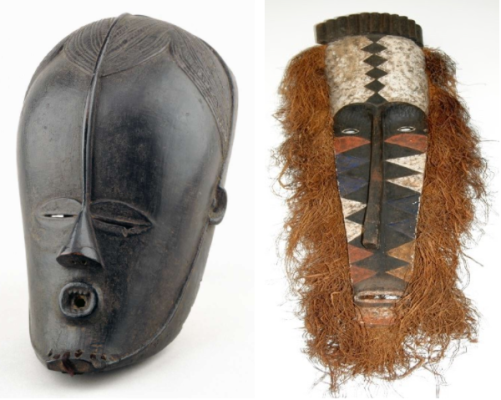
Figure 15.11 (right): “Fang” Maker(s) of central Gabon. Ngil Mask. ca. 1950-1980 CE. Painted wood, fiber, 6’ 5 ¾”. UTA African Art Collection. Photo by Leighton McWilliams; CC BY-NC-SA 4.0.
Scholars trace Modigliani’s introduction to African arts to his apprenticeship with Constantin Brâncuși, a prominent Modern artist who challenged the Western Canon by looking to ‘exotic’ and ‘primitive’ cultures for inspiration, along with others like Paul Gauguin (in quite problematic ways [Goddard 2008]). Another of these artists was Pablo Picasso.
You may be surprised to hear that Picasso was influenced by African art, if you only listen to what Picasso said on the matter. For example, a newspaper quoted Picasso as saying, “African art? Never heard of it!” Unlike Van Gogh and Modigliani, Picasso chose to appropriate features of African art, in famous works like Les Demoiselles d’Avignon, without giving credit to this influence.
Scholars have documented his perception of African art began with visits to the Musée d’Ethnographie du Trocadéro (eventually the Musée de l’Homme) in Paris only months before the completion of Les Demoiselles. He and many of his artist friends eventually owned African arts (check out this photo of him with African sculpture in his studio in 1908). Picasso described his artistic style as ‘primitivism,’ seeking to “liberate an utterly original artistic style of compelling, even savage force” (Hunter and Jacobus 1977: 135-136). Like many male artists of his time (and today), Picasso believed in the age-old Western Canon narrative of the ‘genius’ artist who innovates and originates (but does not appropriate). Thus, he highlighted that he did not ‘borrow from’ nor was he ‘influenced by’ African art, but that he recognized an interest in evoking the metaphysical through abstract means in many African arts, which was an important facet of his own approach to art.
During Picasso’s lifetime, famous exhibitions like the 1913 Armory Show (aka International Exhibition of Modern Art) displayed works like his alongside ‘tribal’ objects, delineating the linkages that Picasso felt were beneath him. More recent exhibitions have continued this dialogue, such as the Museum of Modern Art exhibition by William Rubin and Kirk Varnedoe in 1984 and “Primitivism Revisited: After the End of an Idea” in 2006-2007 CE (curated by students, btw!).
The title “Primitivism Revisited: After the End of an Idea” demonstrates that ‘primitivism’ is now recognized as an incredibly biased and problematic term. Remember the discussion of terms like ‘exotic,’ ‘savage,’ and ‘tribal’ in “Where Does Art Come From? An Introduction”? The dichotomy of ‘civilized’ and ‘uncivilized’ is a creation of Western history and was a big part of the colonial projects of Cecil Rhodes (from “Why Does Size Matter?”) and Leopold II (from “Why Do They Have More Than Us?”). Setting up this difference allowed European and Euro-American colonists to feel better about their practices, since they felt superior to those they colonized, enslaved, and treated poorly. Artists of the Modern period couldn’t yet see past the prejudice of Western history but did see through the tropes of Western art, so long prioritizing naturalistic figures and landscapes. The Impressionists, Cubists, and others challenged the expectation for realistically rendered bodies and realistic landscapes, so vaunted as ‘civilized’/‘high’ art, by considering what they saw as the opposite: ‘uncivilized’/’low’ art. Check out “The White Peril and L’Art negre: Picasso, Primitivism, and Anticolonialism” (Leighten 1990) to consider this topic in depth.
This turn involved heavy appropriation without the type of credit we would expect today. It is through research on artists like Picasso that we have seriously questioned appropriation, especially that across cultural/ethnic boundaries, as a way of making art. Are artists allowed to borrow from other artists (visually, in content, in meaning) without clearly acknowledging that influence? Can you do it if you won’t profit from it? Appropriation Art definitely added to that conversation. It continues to be a subject of controversy and legality, as the next example demonstrates.
To understand this next example, let’s discuss an important tradition of Aboriginal people of present-day northern Australia. Remember Emily Kame Kngwarreye from “Will You Tell a Story?” Her experiences as an artist began from within the Ahalkere Aboriginal community, focused on traditional arts of the desert. In the northern territories and islands off the coast of Australia, distinct Aboriginal communities practiced unique artforms, such as ‘bark painting’ or ‘plank painting.’ Plank Painting (Fig. 15.12) represents three figures, with features of birds and amphibians (potentially in hybrid forms), on a relatively small plank of wood. Oral histories identify these painted figures as ancestral spirits who move through Dreamtime (refer back to the discussion of Aboriginal spiritual thought in “Will You Tell a Story?”)

Unfortunately, Plank Painting was taken from Clack Island by members of the Alert, a British Royal Navy ship that navigated the Pacific between 1878 and 1882 CE. The medical officer of the Alert, R. W. Coppinger, published an account (with at least four editions) of the voyage in Cruise of the “Alert”: Four Years in Patagonian, Polynesian, and Mascarene Waters (1878-82) wherein he describes:
A careful hunting of the holes and crevices in the face of the cliff resulted in the acquisition of some portable specimens of native art in the shape of drawings on old pieces of driftwood, on Melo shells, turtle skulls, and tortoise shell. These luckily afforded us good examples of the style of art, and were accordingly, and without many conscientious scruples as to the sacred rights of ownership, carried off in triumph and deposited on board (Coppinger 1899, 192).
The Alert crew effectively stole these items from Clack Island, which was an incredibly important location for the Yidhu Warra Aboriginal people. The island served as a ceremonial hub to honor the recently deceased and the ancestors of the Dreamtime. The sailors of the Alert, by the open admission of the medical officer, disregarded the rights of the creators and keepers of these objects, scooping them up as treasures of British exploration. The items collected by the Alert eventually made their way to London and became possessions of the British Museum.
The ‘sacred rights of ownership’ mentioned by Coppinger did not receive specific official treatment until well after the Clack Island incident. What is called Native Title in Australia (or Aboriginal Title in Canada or Customary Title in New Zealand) started to develop with the Aboriginal Land Rights Act of 1976 but was not effective until 1993 CE with the Native Title Act. This law is meant to ensure that indigenous peoples of Australia have rights to traditionally held lands, including the ‘property’ upon those lands. Rights to land are important and were very long overdue by 1993. But there are other rights that indigenous Australians had to fight for.
Aboriginal artist John Bulun Bulun is known as the foremost voice that “push[ed] the boundaries of Australian intellectual property law” to benefit indigenous peoples (Hardie 1997, 1). The case Bulun Bulun v. R&T Textiles (1998) focused on the use of Bulun Bulun’s imagery called Magpie Geese and Water Lilles at the Waterhole (1980, ochre on bark) by R&T Textiles, a t-shirt manufacturer in Queensland, Australia (BAC 2021). By the 1980s, Bulun Bulun was a well-known Aboriginal artist whose work was published, like Kngwarreye’s, by gallery owners, museums, and art scholars. Bulun Bulun was especially known for his associations with Maningrida Arts & Culture. In 1997 CE, most Australians, including the people at R&T Textiles, did not consider the arts of Aboriginal people to hold the same intellectual property rights that were attributed to ethnically European Australian artists. Bulun Bulun’s design was appropriated by R&T Textiles, printed on t-shirts, and sold without his consent. This was not the first time something like this happened. Bulunbulun saw this as an opportunity to change things for indigenous people and took the company to court.
The first hurdle in these legal battles was deciding whether indigenous art could be considered original, and thus protected under Australian copyright law. This question of originality relates to the ‘ownership’ of ancestral knowledge and, therefore, relates to recognition of Native Title. To understand the indigenous point of view, law writer Martin Hardie (1997, 3) cites Howard Murphy’s (1992) book Ancestral Connection and John Bulun Bulun himself stating that “paintings are one manifestation of the ancestral world” because they represent “ritual knowledge (madayin)” handed down by the ancestors. Bulun Bulun demonstrated that madayin underpins all his artworks, that it is not public knowledge, and therefore that it is proprietary/owned privately. Thus, his artworks are subject to copyright law. The Australian courts agreed and Bulun Bulun’s case established precedent for indigenous peoples to retain the rights to their art, like any other artist might.
The official recognition of indigenous intellectual property rights in Australia is an important milestone along the trajectory of global indigenous rights and recognition. In the US, there has been a long history of denying the intellectual property of Native Americans, before copyright law even existed. European settlers of North America started using the Mississippi River as a primary route in the late 1600s CE. Along the way, they came in contact with numerous Native American settlements and observed huge complexes of earth mounds, such as those at Cahokia near present-day St. Louis, Missouri. These earth mounds were not random accumulations of dirt but human-built platforms supporting large wooden structures, like Monk’s Mound at Cahokia (Fig. 15.13). Hernando De Soto even noted in his journals about witnessing mounds being built in the southern Mississippi region in 1541 CE. Some very special mounds, called effigy mounds, weren’t platforms for buildings but were built to represent sacred animals, such as Serpent Mound (Fig. 15.14 and check out an aerial photo of the entire complex here). These were ceremonial gathering places and may have served astronomical observation rituals. These examples were built in different time periods by different cultures but represent the longevity and diversity of the mounds.

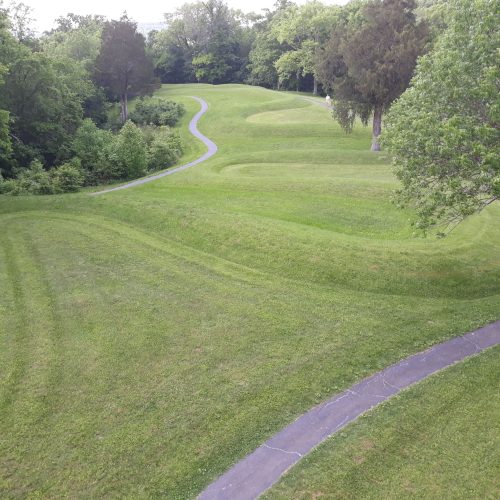
Any guesses whether the Euro-Americans who encountered these mounds gave credit to Native Americans for creating them? You guessed it… Nope. As they learned about Native Americans and about the land they lived on, Euro-Americans (who definitely wanted that land for their own settlements) developed what archaeologists call ‘just-so stories.’ These are narratives that feel ‘just-so’ or ‘just-right’ because they explain the world according to what we want to believe (not what is actually true). Euro-American settlers developed various mythologies about who may have built the fascinating mounds (ignoring the eyewitness accounts of Native Americans building them), collectively known as the ‘Myths of the Moundbuilders.’ The term ‘moundbuilders’ was developed to describe this unknown group of people and to theorize who they were. Maybe they were giants who could easily and quickly move dirt and rocks long distances? Maybe they were people from Israel who came here well before the first European colonists? Maybe they were writers of tablets “found” near the mounds? Nope, nope, and nope. Euro-American settlers were unwilling to acknowledge creatorship, intellectual property, and ownership of Native Americans.
By 1894 CE, Cyrus Thomas published the Report on the Mound Explorations of the Bureau of Ethnology after years of scientific excavations that disproved all previous theories and myths and proved that the ancestors of currently-living Native American cultures built the mounds. The cultures of the 1890s CE were no longer building mounds due to impacts like European-borne disease, conflict, and migration. Unfortunately, Thomas’ work and the work of many recent archaeologists to document the achievements of Native Americans is still not part of mainstream awareness of American history. Cahokia and Serpent Mound rarely make it into our textbooks. To learn more about “just-so stories” and archaeology, check out Frauds, Myths, and Mysteries: Science and Pseudoscience in Archaeology (Feder 2011). The lack of recognition and prejudice continue to impact Native American communities today.
Many contemporary Native American artists grapple with what has been lost or taken from their culture through the formation of the United States out of their ancestral lands. For example, Zig Jackson (Mandan, Hidatsa, and Arikara Tribes) created Indian Photographing Tourist Photographing Indians, Crow Fair, Montana (Fig. 15.15). The photograph depicts a tourist visiting the Crow Fair (a public event) at the Crow Indian Reservation in Montana taking a picture of two elderly Apsáalooke (Crow) people sitting in lawn chairs. The woman with the camera appears to be taking a candid shot of the elderly couple, who appear to be partaking in fair activities. If she is a journalist or media professional, the woman would be required to get the couple’s consent to publish their photograph but she doesn’t have to get their consent to take it. In fact, it looks like the elderly couple is surprised and/or isn’t pleased to be the subject of her photo.
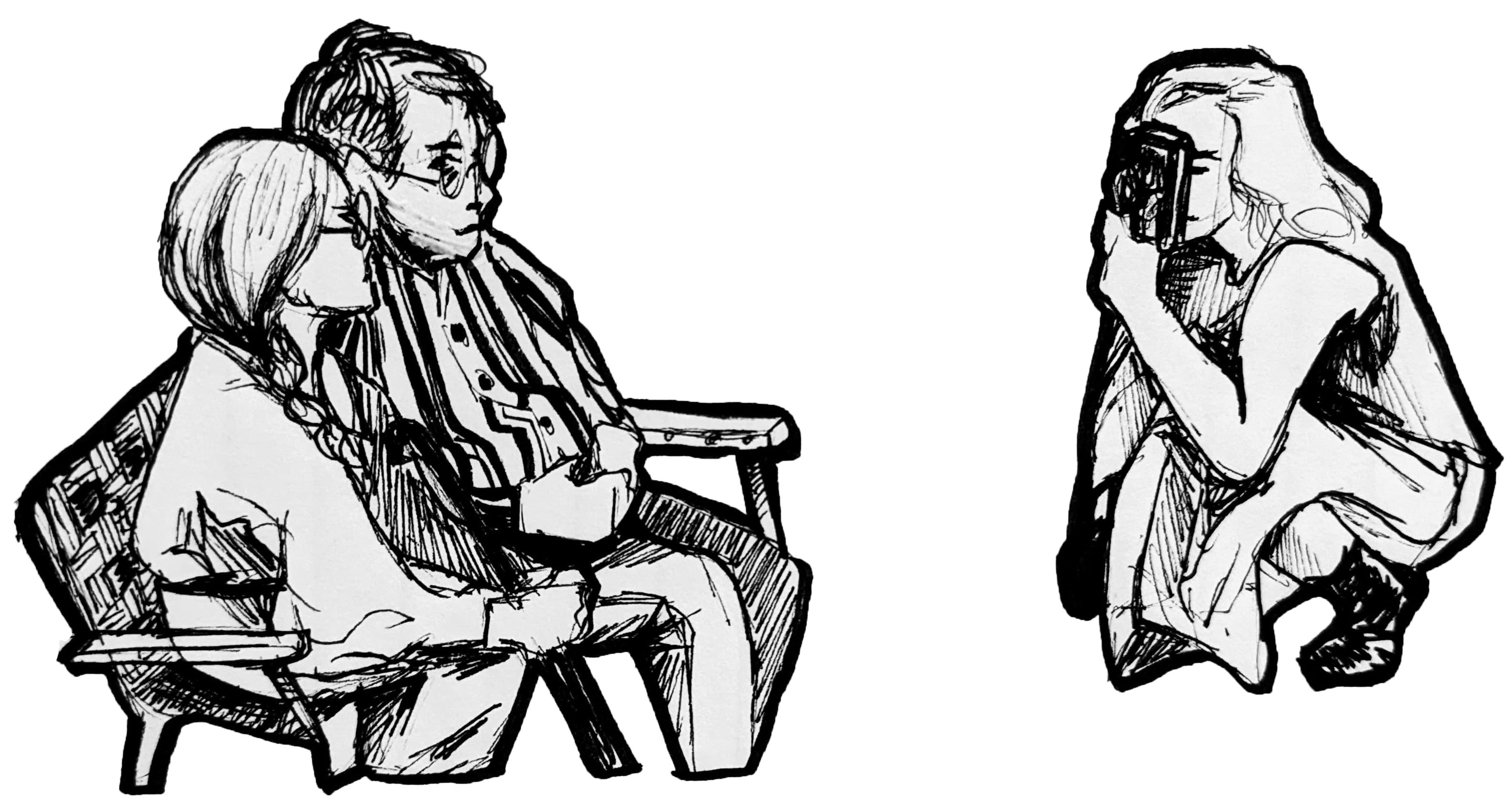
Zig Jackson was visiting that Crow Fair in 1991 CE and saw this scene play out, choosing to document it with his own camera. As a Native American man, he recognized the presumption of the white woman in capturing the likeness of the elderly couple. To many white American audiences, imagery of elderly Native Americans evokes the ‘out of time’ or ‘stuck in the past’ or ‘naive in the face of progress’ stereotypes ascribed to Native American culture. You may have seen another related stereotype, the ‘Crying Indian’, in a famous commercial: Keep America Beautiful (Fig. 15.16).
The curated Native American image used in that commercial derives primarily from the portrayal of Native Americans in western genre films, including famous characters like Tonto. In the commercial, the ‘Crying Indian’ represents the ideal state of nature and attachment to the land that should inspire everyone to not litter or pollute. In fact, the actor, known as ‘Iron Eyes Cody,’ is not Native American but Italian-American Espera Oscar de Corti. By wearing a feather, long braids, hide clothing, and moccasins, de Corti transformed into the expected image of a Native American.
Zig Jackson observing and documenting the white photographer in Indian Photographing Tourist Photographing Indians, Crow Fair, Montana was turning the gaze onto the image/stereotype makers. Jackson documents how stereotypes get made and perpetuated. As we view Jackson’s photograph, we should question what the woman with the camera did with the images she shot that day, where they might be published, what campaign they may have been used for, and whether they perpetuate stereotypes about Native Americans.
There are many other stereotypes of Native Americans, such as the ‘Redman’ stereotype seen in Disney’s 1953 CE version of “Peter Pan” (Fig. 15.17). The stereotypical and problematic terms ‘savage’ and ‘wild’ often are applied to Native American traditions and individuals such as ‘Ishi,’ the so-called ‘last wild Indian.’ He was a member of the Yahi culture of Deer Creek (present-day California) that lived outside of Euro-American settlement for as long as they could. All of his family members died due to conflicts with white settlers and he was taken into custody by police officers ‘for his own good’ in 1911 CE. He was considered ‘wild’/‘uncivilized’ and was transferred to University of California, Berkeley, where he was studied by anthropologists and eventually became a live-in janitor. He died after 5 years there.
‘Ishi’ had his community, identity, and personal choice taken away. He never revealed his personal name (‘Ishi’ just means “grown man” in the Yahi/Yana language) and never lived among Native Americans again. Upon his death, his body was autopsied against his wishes and his brain was preserved in museum collections until 1999 CE. In 2000, his remains were returned to his descendants, following the Native American Graves Protection and Repatriation Act (NAGPRA) of 1990. His remains were buried in an undisclosed location. The losses and thefts that ‘Ishi’ endured are unimaginable.
The story of ‘Ishi’ deeply affected contemporary artist James Luna (1950-2018 CE). As a member of the La Jolla Indian Reservation in California, Luna identified with ‘Ishi’ on a personal level and reflected upon what he went through as an exhibit at UC Berkeley. These reflections inspired a performance and installation artwork called The Artifact Piece (Fig. 15.18). The body in the display case, with various labels, is actually James Luna himself. Luna would lay in the display case, with his chest rising and falling with his breath (clearly demonstrating life), while visitors read the labels about his personal items, visible scars on his body, and his still ongoing life. He challenged the ever-present idea that Native Americans are dead or dying out. ‘Ishi’ was the ‘last of his kind’ and many representations of Native Americans in museums focus on bones of deceased people. Luna said this work was a reaction to how his community was represented in museums and to the public:
We were simply objects among bones, bones among objects, and then signed and sealed with a date. In that framework you really couldn’t talk about joy, intelligence, humor, or anything that I know makes up our people.
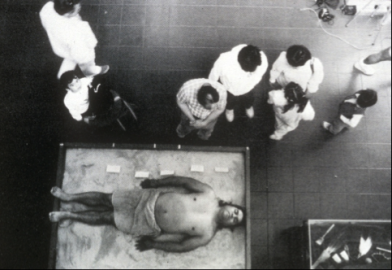
Luna was also known for his performance called Take a Picture with a Real Indian (Fig. 15.19), first performed in 2001. You’ll see in the video below that Luna presents himself in various ways to see how audience members will react based on their perceptions of what a ‘real Indian’ should be. He continued to evolve this performance, eventually locating it in front of the Columbus monument at Union Square in Washington D.C. on Columbus Day, which many people prefer to call Indigenous Peoples’ Day (October 12 annually). To see more of Luna’s work, read “Remembering James Luna (1950-2018)” (Hill 2018).
The Wrap-up
The historic treatment of and impacts on Native American communities are prominent reasons why we develop land acknowledgement statements like the one presented at the beginning in “How to Read this Book.” Did you skip over that? We want to make sure you read it and understand why it is there. Our institutions, businesses, and homes occupy land that Native American groups consider ancestral lands, part of their Native Title or ancestral right. The process by which the United States was created involved undermining indigenous systems of thought and stewardship of the land for the benefit of Euro-American settlement. This cannot be forgotten or ignored. For that reason, we provide the land acknowledgement statement for the University of Texas at Arlington, the institution that sponsored the development of this book, again:
The University of Texas at Arlington respectfully acknowledges the Wichita and Affiliated Tribes upon whose historical homelands the university is located. Their ancestors resided here for generations before being violently displaced by US settlers and soldiers in the mid-1800s CE. We recognize the historical presence of the Caddo Nation and other Tribal Nations in the region, the ongoing presence and achievement of many people who moved to the area due to the Indian Relocation program of the 1950s and 1960s CE, and the vital presence and accomplishments of our Native students, faculty, and staff.
Check out the Native Land resource below to consider the native associations specific to where you live, work, or go to school. And check out the other links and scholarly resources to continue thinking about the intersections of art and loss.
News Flash
- The non-profit Native Land created a map of the Americas documenting the native groups who originally lived in and/or were displaced from locations across the continent.
- Go beyond “What Makes the Redman Red” in Disney’s 1953 “Peter Pan” to consider how Native American traditions are appropriated throughout the film, and in the live-action adaptation ”Hook” (1991).
- Check out the podcast “Stuff You Missed in History Class” episode focused on Peruvian archaeologist Julio Tello, who worked his whole career to reduce the loss of Peruvian archaeological heritage.
- The Bamiyan Buddhas were reinstated, in a way, via 3D projection to commemorate the 20th anniversary of their destruction.
Where Do I Go From Here? / The Bibliography
Goddard, Linda. 2008. “‘The Writings of a Savage’? Literary Strategies in Gauguin’s Noa Noa,”
Hunter, Sam and John Jacobus, 1977. Modern Art. New York: Prentice-Hall. 135–136.
Khan, Muhammad W. 1964. Inception of Gandhāra Sculpture.” East and West 15, so. 1-2 (January):53-61. https://www.jstor.org/stable/29754868?seq=1.

